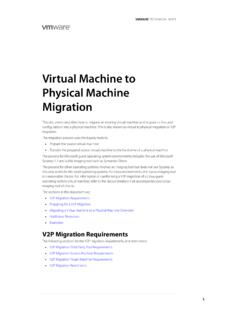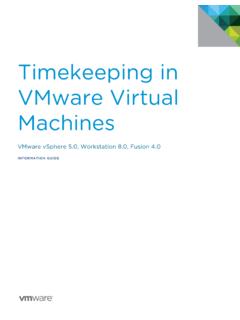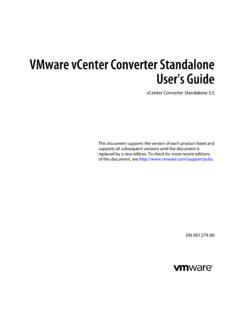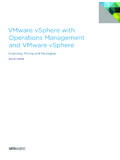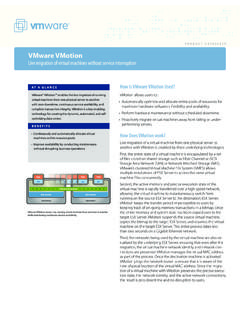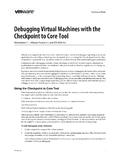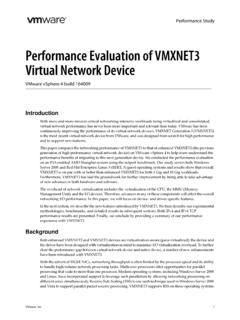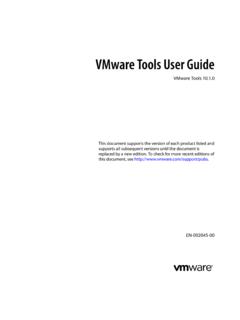Transcription of Understanding Memory Resource Management in …
1 Understanding Memory Resource Management in vmware ESX ServerW H I T E P A P E R 2V M wa r e w h i t e pa p e rTable of Contents1. Introduction..32. eSX Memory Management Overview .. terminology.. Memory Virtualization Basics .. Memory Management Basics in eSX..53. Memory reclamation in eSX.. Motivation .. transparent page Sharing (tpS) .. Ballooning .. hypervisor Swapping.. when to reclaim host Memory ..104. eSX Memory allocation Management for Multiple Virtual Machines ..115. Performance evaluation .. experimental environment .. transparent page Sharing performance .. Ballooning vs.
2 Swapping.. Linux Kernel Compile.. Oracle/Swingbench .. SpeCjbb .. Microsoft exchange Server 2007 ..186. Best Practices ..197. references ..193V M wa r e w h i t e pa p e r1. IntroductionVMware ESX is a hypervisor designed to efficiently manage hardware resources including CPU, Memory , storage, and network among multiple concurrent virtual machines. This paper describes the basic Memory Management concepts in ESX, the configuration options available, and provides results to show the performance impact of these options. The focus of this paper is in presenting the fundamental concepts of these options.
3 More details can be found in Memory Resource Management in vmware ESX Server [1]. ESX uses high-level Resource Management policies to compute a target Memory allocation for each virtual machine (VM) based on the current system load and parameter settings for the virtual machine (shares, reservation, and limit [2]). The computed target allocation is used to guide the dynamic adjustment of the Memory allocation for each virtual machine. In the cases where host Memory is overcommitted, the target allocations are still achieved by invoking several lower-level mechanisms to reclaim Memory from virtual machines.
4 This paper assumes a pure virtualization environment in which the guest operating system running inside the virtual machine is not modified to facilitate virtualization (often referred to as paravirtualization). Knowledge of ESX architecture will help you understand the concepts presented in this order to quickly monitor virtual machine Memory usage, the vmware vSphere Client exposes two Memory statistics in the Resource summary: Consumed Host Memory and Active Guest Memory . Figure 1: Host and Guest Memory usage in vSphere ClientConsumed Host Memory usage is defined as the amount of host Memory that is allocated to the virtual machine, Active Guest Memory is defined as the amount of guest Memory that is currently being used by the guest operating system and its applications.
5 These two statistics are quite useful for analyzing the Memory status of the virtual machine and providing hints to address potential performance paper helps answer these questions: Why is the Consumed Host Memory so high? Why is the Consumed Host Memory usage sometimes much larger than the Active Guest Memory ? Why is the Active Guest Memory different from what is seen inside the guest operating system? These questions cannot be easily answered without Understanding the basic Memory Management concepts in ESX. Understanding how ESX manages Memory will also make the performance implications of changing ESX Memory Management parameters vSphere Client can also display performance charts for the following Memory statistics: active, shared, consumed, granted, overhead, balloon, swapped, swapped in rate, and swapped-out rate.
6 A complete discussion about these metrics can be found in Memory Performance Chart Metrics in the vSphere Client [3] and VirtualCenter Memory Statistics Definitions [4].The rest of the paper is organized as follows. Section 2 presents the overview of ESX Memory Management concepts. Section 3 discusses the Memory reclamation techniques used in ESX. Section 4 describes how ESX allocates host Memory to virtual machines when the host is under Memory pressure. Section 5 presents and discusses the performance results for different Memory reclamation techniques. Finally, Section 6 discusses the best practices with respect to host and guest Memory M wa r e w h i t e pa p e r2.
7 ESX Memory Management TerminologyThe following terminology is used throughout this paper. Host physical memory1 refers to the Memory that is visible to the hypervisor as available on the system. Guest physical Memory refers to the Memory that is visible to the guest operating system running in the virtual machine. Guest virtual Memory refers to a continuous virtual address space presented by the guest operating system to applications. It is the Memory that is visible to the applications running inside the virtual machine. Guest physical Memory is backed by host physical Memory , which means the hypervisor provides a mapping from the guest to the host Memory .
8 The Memory transfer between the guest physical Memory and the guest swap device is referred to as guest level paging and is driven by the guest operating system. The Memory transfer between guest physical Memory and the host swap device is referred to as hypervisor swapping, which is driven by the Memory Virtualization BasicsVirtual Memory is a well-known technique used in most general-purpose operating systems, and almost all modern processors have hardware to support it. Virtual Memory creates a uniform virtual address space for applications and allows the operating system and hardware to handle the address translation between the virtual address space and the physical address space.
9 This technique not only simplifies the programmer s work, but also adapts the execution environment to support large address spaces, process protection, file mapping, and swapping in modern computer systems. When running a virtual machine, the hypervisor creates a contiguous addressable Memory space for the virtual machine. This Memory space has the same properties as the virtual address space presented to the applications by the guest operating system. This allows the hypervisor to run multiple virtual machines simultaneously while protecting the Memory of each virtual machine from being accessed by others.
10 Therefore, from the view of the application running inside the virtual machine, the hypervisor adds an extra level of address translation that maps the guest physical address to the host physical address. As a result, there are three virtual Memory layers in ESX: guest virtual Memory , guest physical Memory , and host physical Memory . Their relationships are illustrated in Figure 2 (a).Figure 2: Virtual Memory levels (a) and Memory address translation (b) in ESX(a)VM(b)Guest virtualmemoryApplicationOperating SystemHypervisorHypervisorGuest physicalmemoryHost physicalmemoryGuest OSPage Tablesguest virtual-to-guest physicalShadow PageTablesguest virtual-to-guest physicalpmapguest physical -to-host physicalAs shown in Figure 2 (b), in ESX, the address translation between guest physical Memory and host physical Memory is maintained by the hypervisor using a physical Memory mapping data structure, or pmap, for each virtual machine.
